#certificate in building information modelling
Explore tagged Tumblr posts
Text
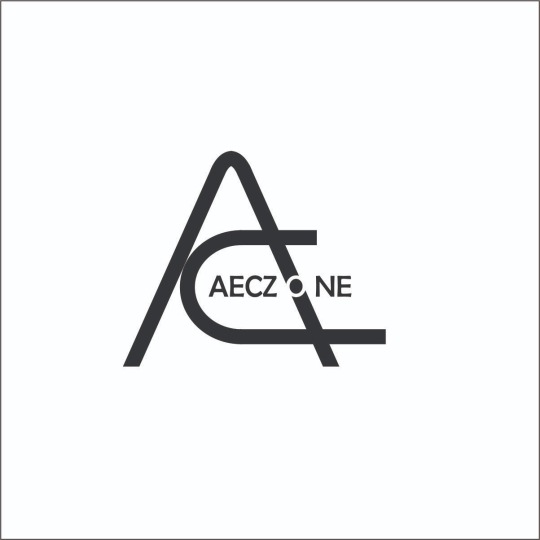
BIM Software Learning | BIM Certificate Programs- Aeczone Academy
#architecture#certificate in building information modelling#online bim certificate programs#learn bim online#bim classes#bim architecture course#bim certification courses#bim course with placement#bim modeling course#building information modeling course#bim engineer course#bim learning online#bim software learning
3 notes
·
View notes
Text
UNILAG and Casting Crown Partner to Enhance Sustainability and Project Management Skills in Students
In a bid to equip Nigerian students with industry-ready skills, Casting Crown, a leading firm in professional development, has launched a transformative initiative aimed at empowering 10,000 students across 20 universities in Nigeria over the next five years. Bridging the Skills Gap with Globally Recognized Certifications This initiative is structured around the World Bank’s International…
#Building Information Modelling training UNILAG#IFC EDGE program Nigeria#Industry-ready skills for Nigerian graduates#Project management training in Nigerian universities#UNILAG sustainability certification
0 notes
Text
The Role of BIM Outsourcing in Sustainable Building Design

In an era where environmental consciousness and sustainability are paramount, the construction and architecture industries are increasingly turning to Building Information Modeling (BIM) to streamline projects and enhance sustainability. BIM, a digital representation of a building's physical and functional characteristics, has revolutionized how structures are designed, built, and managed. As the demand for sustainable building design grows, the role of BIM outsourcing has become more critical than ever. This blog post explores how BIM outsourcing contributes to sustainable building design and why it is an indispensable tool for the modern construction industry.
The Intersection of BIM and Sustainability
BIM facilitates the creation of accurate and detailed digital models that provide a holistic view of a building's life cycle, from design and construction to operation and maintenance. This comprehensive perspective enables architects, engineers, and construction professionals to make informed decisions that enhance sustainability. Key sustainability benefits of BIM include:
Energy Efficiency: BIM allows for precise energy modeling and simulation, enabling the design of energy-efficient buildings. It helps identify potential areas for energy savings, optimize HVAC systems, and select sustainable materials.
Material Optimization: By providing accurate quantity take-offs and detailed material specifications, BIM minimizes waste and ensures the efficient use of resources. This is crucial in reducing the carbon footprint of construction projects.
Improved Collaboration: BIM's collaborative platform fosters communication and coordination among project stakeholders, reducing errors and rework. This efficiency not only saves time and costs but also minimizes the environmental impact associated with construction activities.
The Advantages of BIM Outsourcing
BIM outsourcing involves delegating BIM-related tasks to specialized firms or professionals who possess the expertise and technology required to execute complex BIM processes. This approach offers several advantages, particularly in the context of sustainable building design:
Access to Specialized Expertise: Outsourcing firms often have a team of skilled BIM professionals who are well-versed in the latest technologies and sustainable design practices. They bring specialized knowledge and experience, ensuring high-quality BIM deliverables that align with sustainability goals.
Cost-Effectiveness: Developing an in-house BIM team can be expensive, requiring investment in software, training, and personnel. Outsourcing provides a cost-effective solution, allowing companies to access top-notch BIM services without the overhead costs.
Scalability and Flexibility: BIM outsourcing offers the flexibility to scale services according to project requirements. Whether a project demands extensive BIM modeling or specific sustainable design analysis, outsourcing firms can tailor their services to meet the needs of the project.
Focus on Core Competencies: By outsourcing BIM tasks, architecture and construction firms can focus on their core competencies, such as design innovation and project management. This focus enhances overall project quality and sustainability outcomes.
How BIM Outsourcing Enhances Sustainable Building Design
BIM outsourcing plays a crucial role in achieving sustainable building design by providing the expertise and technology necessary to implement sustainable practices effectively. Here are some specific ways in which BIM outsourcing contributes to sustainability:
1. Energy Performance Analysis
One of the primary goals of sustainable building design is to reduce energy consumption. BIM outsourcing firms utilize advanced energy modeling software to simulate a building's energy performance. These simulations consider various factors, such as building orientation, insulation, glazing, and HVAC systems, to optimize energy efficiency. By outsourcing this task, project teams gain access to cutting-edge tools and methodologies that may not be available in-house.
2. Lifecycle Assessment
BIM outsourcing enables comprehensive lifecycle assessments (LCA) of building materials and systems. LCA evaluates the environmental impact of materials throughout their lifecycle, from extraction and production to disposal. By analyzing these impacts, BIM professionals can recommend sustainable alternatives and strategies to minimize environmental footprints. This assessment is crucial for making informed decisions about material selection and construction methods.
3. Green Building Certification
Achieving green building certifications, such as LEED (Leadership in Energy and Environmental Design) or BREEAM (Building Research Establishment Environmental Assessment Method), is a significant milestone in sustainable building design. BIM outsourcing firms often specialize in preparing the documentation and analysis required for these certifications. They ensure that all aspects of the design meet the stringent criteria set by certification bodies, enhancing the building's sustainability credentials.
4. Waste Reduction and Recycling
BIM's ability to provide accurate material quantities and specifications aids in reducing construction waste. BIM outsourcing firms excel in creating precise models that minimize over-ordering and waste. Additionally, they can integrate sustainable practices, such as recycling and reusing materials, into the construction process. This not only reduces waste but also lowers project costs and environmental impact.
5. Sustainable Urban Planning
Beyond individual buildings, BIM outsourcing can contribute to sustainable urban planning. By creating detailed models of entire neighborhoods or districts, BIM professionals can analyze the environmental impact of large-scale developments. This analysis includes factors such as transportation networks, green spaces, and water management systems. The insights gained from these models guide the design of sustainable urban environments that promote energy efficiency and reduce carbon emissions.
Challenges and Considerations in BIM Outsourcing
While BIM outsourcing offers numerous benefits, it is essential to consider potential challenges and ensure effective collaboration between in-house teams and outsourcing partners. Key considerations include:
Communication and Coordination: Effective communication is critical to ensure that the outsourcing firm understands the project's sustainability goals and requirements. Regular updates and collaboration are necessary to align all stakeholders.
Data Security: As with any outsourcing arrangement, data security is a concern. It is vital to establish robust data protection protocols and ensure that sensitive project information is handled securely.
Quality Control: Maintaining quality standards is crucial in BIM outsourcing. It is essential to select a reputable outsourcing firm with a proven track record of delivering high-quality BIM services.
Conclusion
BIM outsourcing is a valuable strategy for achieving sustainable building design. It offers access to specialized expertise, cost-effective solutions, and advanced technologies that enhance the sustainability of construction projects. By leveraging the capabilities of BIM outsourcing firms, architects and construction professionals can optimize energy performance, reduce waste, and achieve green building certifications. As the construction industry continues to prioritize sustainability, the role of BIM outsourcing in delivering environmentally responsible designs will only grow in importance. By embracing this approach, companies can contribute to a greener, more sustainable future.
#BIM Outsourcing#Sustainable Building Design#Sustainable#Building Design#Building Information Modeling (BIM)#Green Building Certification#Waste Reduction#Urban Planning#bim modeling services#bim outsourcing services#outsource bim services#revit modeling services#3d bim modeling services#bim modeling service#bim modelling services#building information modeling services#outsourcing bim#revit bim modeling services#revit outsourcing services#bim outsourcing companies in usa#outsource bim services india#bim modeling outsourcing#bim outsourcing company#bim drafting outsourcing#architectural bim modeling services outsourcing#bim design outsourcing
0 notes
Note
I'm sorry if you already posted this, but this is about the details of the first cars movie, what was the car Pixar used for Lightning McQueen's sounds, bc I cannot for the life of me remember
ONE OF MY FAVORITEST TOPICS!!!!!!!!!!
so lightning, being a 2006 model/cars being in production in the early aughts, is based off of a gen4 NASCAR build. specifically a chevy monte-carlo of the early aughts, as seen in some of his early designwork:

[jogen klubein, 2000]

[bob pauley, 2002] [the art of cars]
some stats:

(from some sketchy assed 2000 website i wont link it but i do have it written down)
i used to swear up and down that there was a special feature that showed a few of the guys from skywalker sound recording one of the g4s (maybe a blue and white dodge??) at skywalker ranch in california (or at the airstrip with the other cars). it may have been an old interview or its on a blu-ray special feature somewhere, but i havent been able to find it. i either dreamt it up or its been lost?? no idea.
but what i have been able to find is some of the stock audio used in Cars. Supposedly this is work done by Ben Burtt at skywalker sound [lucasfilm] in the late 70's??: [link]
For NASCAR purposes, as far as i could tell their engines didnt change drastically from the 70s-2000's, so its not wholly inaccurate to use older clips.
a thing in my notes:

[mixonline. photo dead from link rot]
and now some examples of real-life mcqueens (an excuse to show you cool old stock cars) :
youtube
youtube
youtube
youtube
and a few various other references:
youtube
youtube
youtube
(note the flywheel sound we also hear in Cars!)
youtube
^video ive only skimmed so far but seems very informative.
and a few canon refs while im here:

[image mine, circa 2020. official 1:18 scale BANDAI replica with certificate of authenticity, approved by jay ward]


[time travel mater] (his carbon fiber cowl induction cover is very funny to me)
SO. to answer the question: its a mix of custom sound design and stock audio. its based in reality heavily, but i believe its also tuned for fiction/per character personality. i forget which interview said that it might be the mixonline one mentioned above or this old autoweek one. he's got something along the lines of partly SB2.2 and an R07. this does not mean pixar recorded specifically these motors, but prooobably something close.
and cars 3 pisses me off because they very clearly did not use any audio off of the g4s, which had a more specific screaming sound to them at high RPMs. COTR actually portrays his exhaust note more accurately than cars 3. Cars 2 is decent also, but the first film is chefs kiss.
i have more various unorganized lmq references but this ask is long enough now and probably doesnt make much sense because i am literally so amped about this topic. please note that this research is partly accurate and partly speculative/opinion. rejoice, mcqueens be upon ye.
#lightning mcqueen#anon#ask#reply#real cars#pixar cars science#hc#the 'sketchy 2000's website' is not sketchy bc its Bad. its just got old security and i will not point traffic there#it hadnt been updated since 2003 or smth#its hard to find old nascar stuff bc a lot of this is all from 20-30yrs ago now#i was busy being a toddler yk i gotta dig it all up postmortem#that added to how secretive NASCAR and Disney are??? i am in agony here.
66 notes
·
View notes
Text
A Well-Preserved Abandoned Time Capsule House
Along a scenic road lies this incredible time capsule house with everything left behind. This large home built in 1956 features interior design elements from the 70s including shag carpeting in the bedrooms, a carpeted wall in the primary bedroom, appliances from the same era, and even an Asian-themed tiki bar/room in the basement. There are several personal items left behind as well from clothing, to photos and even letters from the children to their father.

The Home was owned by a German man named Hans. He was born in 1923, and he married a woman named Emma at a relatively young age. Hans was a school teacher by profession, teaching at a nearby school. He was a hard worker and was always furthering his education, as seen in several certificates found throughout the home. I believe he also had a small business selling renewable energy sources such as solar panels and wind turbines which he operated out of a separate part of the home. In his spare time, he liked to build and maintain his elaborate model train display in the basement.


He and his wife Emma enjoyed travelling and did so often until finally deciding to settle down. They had two children, Adele and Michael. They led an idyllic life for a few years but as time went on cracks began to emerge in the marriage. Emma decided it was time to leave and she moved with their children a couple of hours away from Hans.

Hans moved on and met a woman named Ida. Michael would occasionally send letters to Hans and from what I read, they did not have the best relationship. Michael being very religious, was always optimistic they would see each other during the holidays but from the sounds of the letters, that likely didn't happen. He was also upset about the fact that his father did not call him regularly. In one of the letters Michael said that after a phone call with his father, he was scared to death of visiting him after speaking his mind. Emma did not get along well with her ex husband and this likely played a role in the ability for the children to visit with their father as well.


Life continued on for both families until Hans passed away in 1980, he was only 57. Ida lived in the home until at least 1983 as seen in a handwritten letter from Michael addressed to her. At some point after that, Ida moved to Pennsylvania since she likely had friends/family there. The house has sat abandoned ever since.



Emma passed away a few years ago but I have not been able to find out any information about Adele. Michael however spent a lot of time in school training to work in a religious-related field. He had inherited a strong work ethic from his father, reminiscing about how Saturdays were work days and how that impacted his life. He has since found a very rewarding and successful career in religion.
source - video of the house
159 notes
·
View notes
Text
Zelda Liveblogs a Lancet Paper
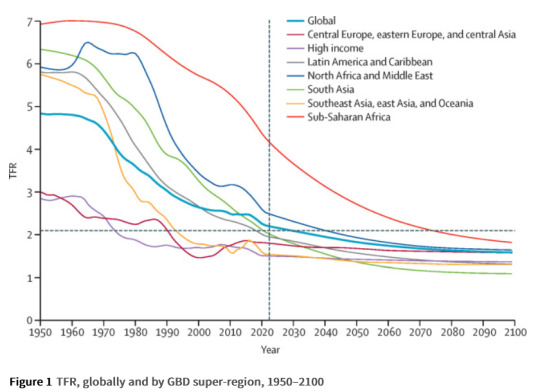
Following this post, I am now going to liveblog reading the Lancet paper cited by the Economist article to predict worldwide fertility to drop by 3/4s of its current position if current demographic trends continue. It is an Open Access article, so the entire thing is open for anyone on the internet to read.
Citation:
GBD 2021 Fertility and Forecasting Collaborators (March 20, 2024). Global fertility in 204 countries and territories, 1950–2021, with forecasts to 2100: a comprehensive demographic analysis for the Global Burden of Disease Study 2021. The Lancet, 403(10440), 2057-2099. https://doi.org/10.1016/S0140-6736(24)00550-6.
I refuse to use Chicago style. This is mostly because I memorized APA and don't want to learn a new one.
First, my background: I am not a demographer; I am not trained as a demographer; I have studied it auxiliarily to my other academic pursuits. I fall in a sort of educated in-between. I am currently a Master's student in library and information sciences, and my undergraduate degree was in political science, both at USAmerican universities. However, the field of economics is also very close to my heart, and I would have double-majored in it if the opportunity and financial costs had not been too high to justify it. During the five years I was a college drop-out, I studied economics independently, reading broadly within the field and taking non-certificate courses online. I've been taking non-certificate courses in economics through correspondence or online since I was about nine. I'm not an expert! I do, however, think I'm a fairly well-informed amateur.
And a note on language. This paper refers to birthing parents as mothers and to the demographic that gives birth interchangeably as female and women. I acknowledge that this is a cissexist patriarchical viewpoint that erases transmen, nonbinary and intersex people, and probably others I'm not thinking of. For consistency between my reflections and the paper and ease of reading, I will do the same. I'm conscious I'm part of the problem here, but don't see a way around it without making my bits harder to understand than they have to be.
With that out of the way, here we go:
Methodology (Summary)
This is where me not being a demographer is an important thing to know. I neither know nor normally care about the statistical methods used to determine demography, just that the demographers aren't retracting papers over it. However, I do know that in general the CCF50 (total cohort fertility before the age of 50) is a neater and more accurate measurement to build projections on than the TFR (total fertility rate by year) and that's the methodology the paper's authors went with. This is good and promising. TFR for known years and CCF50 projections sounds like a solid method. 👍
We additionally produced forecasts for multiple alternative scenarios in each location: the UN Sustainable Development Goal (SDG) for education is achieved by 2030; the contraceptive met need SDG is achieved by 2030; pro-natal policies are enacted to create supportive environments for those who give birth; and the previous three scenarios combined.
I'm very hopeful about these forecasts! They'll show a few different hopeful scenarios.
To evaluate the forecasting performance of our model and others, we computed skill values—a metric assessing gain in forecasting accuracy—by comparing predicted versus observed ASFRs from the past 15 years (2007–21). A positive skill metric indicates that the model being evaluated performs better than the baseline model (here, a simplified model holding 2007 values constant in the future), and a negative metric indicates that the evaluated model performs worse than baseline.
This is a very responsible thing for the authors to have done, and I am interested to see how this is reflected in the models.
.
Findings (Summary)
During the period from 1950 to 2021, global TFR more than halved, from 4·84 (95% UI 4·63–5·06) to 2·23 (2·09–2·38). Global annual livebirths peaked in 2016 at 142 million (95% UI 137–147), declining to 129 million (121–138) in 2021. Fertility rates declined in all countries and territories since 1950,
(Emphasis mine. The numbers in parentheses are the confidence interval.) I think this is the most important takeaway from the whole damn paper. Makes sense, since it's the first line of the findings. If you read nothing else, read these three sentences. Global birthrates are barely above replacement (which, if you recall from my other essay, is generally considered to be ~2.1). To me, this implies lot of problems that traditionally have been considered solvable with population redistribution (meaning, mostly, immigration) may not be solvable that way even if fertility were to stop declining today and hold constant for the rest of the century.
Future fertility rates were projected to continue to decline worldwide, reaching a global TFR of 1·83 (1·59–2·08) in 2050 and 1·59 (1·25–1·96) in 2100 under the reference scenario. The number of countries and territories with fertility rates remaining above replacement was forecast to be 49 (24·0%) in 2050 and only six (2·9%) in 2100, with three of these six countries included in the 2021 World Bank-defined low-income group, all located in the GBD super-region of sub-Saharan Africa.
Holy shit. I cannot emphasize enough how low a TFR of 1.59 is. This is approximately the current TFR of the United Kingdom, and they're beginning to freak out even though they have relatively easy sources of additional replacement recruitment through the Commonwealth. Imagine that for the whole Earth. With only six countries as a potential source of surplus population to be redistributed.
Funding from the Bill & Melinda Gates Foundation. Makes sense. This is the kind of thing that foundation funds.
.
Introduction
Low levels of fertility have the potential over time to result in inverted population pyramids with growing numbers of older people and declining working-age populations. These changes are likely to place increasing burdens on health care and social systems, transform labour and consumer markets, and alter patterns of resource use.
Oh man, I wish I'd gone through this paper earlier, I could have just quoted this bit and been done instead of trying to explain it from scratch! 😂
The UN Population Division estimates of past fertility are not compliant with the Guidelines on Accurate and Transparent Health Estimates Reporting (GATHER) statement in important respects; notably, they do not provide all code for statistical models or explicit details on criteria for exclusion or adjustment of primary data sources. Furthermore, the validity of UN Population Division projections has been questioned due to the assumptions applied in countries experiencing low post-transition fertility dropping below replacement level.
YES GO OFF 👏 The UN Population Division is so much more cagey about their data than the World Bank, it's so annoying, and they keep predicting increases that don't happen. I thought it was so weird as an undergrad but figured it was because of ~bureaucracy~ or privacy laws or whatever. It's nice to be vindicated [redacted] years later.
Our forecasts also suggest that, by 2100, the largest concentrations of livebirths will shift to low-income settings, particularly a subset of countries and territories in sub-Saharan Africa, which are among the most vulnerable to economic and environmental challenges. Extreme shifts in the global distribution of livebirths can be partially ameliorated by improved female education and met need for modern contraception. Outside of this subset of low-income areas, most of the world's countries will experience the repercussions of low fertility, with ageing populations, declining workforces, and inverted population pyramids, which are likely to lead to profound fiscal, economic, and social consequences. National policy makers and the global health community must plan to address these divided sets of demographic challenges emerging worldwide.
This is such an important point for them to make. Demography isn't a vacuum; it has significant real-world effects. By 2100, most babies born will be born in Africa, and we need to plan for that now. By 2100, most countries will not have enough workers, and we need to plan for that now. 2100 is not that far into the future. I, personally, will live to see the beginnings of the effects of this demographic shift, and I'm an adult who pays taxes and has a college degree and shit.
.
The Data Sources and Processing section is pretty standard and unremarkable. Good job.
.
Fertility Forecasting
We produced forecasts of fertility using an updated modelling framework (appendix 1 section 3) that improved on the methods in the 2020 study by Vollset and colleagues. In our updated methods, we used not only estimates of female educational attainment and contraceptive met need as covariates, but also estimates of under-5 mortality and population density in habitable areas to account for a larger variation in CCF50 across all countries in the sub-models (appendix 1 section 3.1, appendix 2 figure S2). Similar to Vollset and colleagues, we continued to forecast fertility with CCF50 rather than TFR, because modelling in cohort space is more stable than in period space.
Niiiiice. Covariates are things that, well, vary, alongside the thing you're trying to measure. For fertility, the most obvious one might be age of the mother at first birth; if someone is 16 at first birth, she probably will have more kids than someone who is 30 at first birth, for example. This model also includes how much schooling the mother gets, whether she has contraception, the mortality rate (that is, how many of them die) of children under five, and population density! That's a lot of statistical crunching and their model will be more precise for it. Precise isn't the same as accurate, but I think that with the variables they selected, they will travel in the same direction.
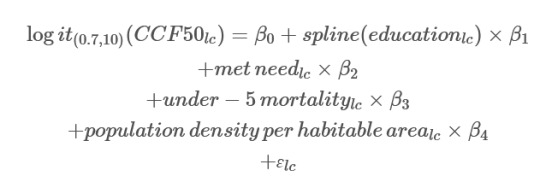
What a pretty equation. I don't understand it, but it's got a certain je ne sais quois.
For the education SDG scenario, the forecasts assume that by 2030, all people will have 12 years or more of education by the age of 25 years and then maintains the same rate of change as the reference scenario up to 2100. For the contraceptive met need scenario, to reflect the SDG scenario of universal access, the forecasts assumed a linear increase in contraceptive coverage to reach 100% by 2030 and then stay constant up to 2100.
I love how optimistic these scenarios are 😂 This truly is the best-case scenario for both the education forecast and the contraceptive forecast! I do hope everybody has 12+ years of education and 100% contraceptive coverage by 2030. Make it happen, António!!!!
(Joke explained: António Guterres is the current Secretary-General of the United Nations, and these goals are absolutely not going to be met by 2030.)
In the pro-natal scenario, we assumed a country will introduce pro-natal policies, such as childcare subsidies, extended parental leave, insurance coverage expansion for infertility treatment, 33 and other forms of support for parents to afford high-quality child-care services, once TFR decreases to less than 1·75. We then made three assumptions on the effects of such policies. First, we assumed the full effect of pro-natal policies will be to increase TFR by 0·2. Second, it will take 5 years after the policy is introduced for the full increase in TFR to occur, and TFR will rise linearly over that time span. Last, we assumed that both the policies and the increase in TFR by 0·2 will endure for the remainder of the century.
The pro-natal scenario is also incredibly optimistic. This kind of response simply hasn't happened in any country that's tried pro-natal policies as envisioned by the authors (my reference cases, just off the top of my head: Japan and France).
The optimism makes sense. They represent extreme cases, in order to contrast possible outcomes versus the reference case. This is good practice! It's just also funny.
.
Results
The Reference Case
I hate the embedded tables. They have the confidence interval in the same cell as the estimate. How very dare they, that's incredibly inconvenient for me personally.
The chart in Figure 1, however, I think speaks volumes:

It speaks so many volumes that I'm gonna go up and put it above the cut, brb. This chart shows the reference case; that is, it shows the fertility rate if the fertility trends of 1950-2021 continue into the future.
At the national level, estimates of TFR in 2021 ranged from 0·82 (95% UI 0·75–0·89) in South Korea to 6·99 (6·75–7·24) in Chad, with below-replacement levels of fertility (TFR <2·1) in 110 of 204 countries and territories (table 1, figures 2A, 3).
I think this range is neat and goes to show that while the trend is world-wide, it's still not even. Chadian women still give birth to about 7ish kids on average. That's more than 3x replacement, and more than 8.5x the average fertility of South Korea. South Korea is going to have different problems than Chad; Chad probably doesn't have to worry as much about their workforce being unable to sustain a large elderly population. (Don't look so cheerful about it. They've got lots of other stuff to worry about. 😬)


These charts are fascinating to look at to me. I think this really showcases just how dramatic the projected decline is. It's not just the Europe, it's not just wealthy post-industrialized countries, but everywhere. It's in Eswanti, it's in Indonesia, it's in Burkina Faso, it's in China. It really shows just how much Chad is an outlier (adn should still be counted, btw, just because it's an outlier doesn't mean we should discard it; it's dependent on study structure and you can't just throw out entire countries because they have high birth rates on a study of birth rates).
Our estimates indicate that there is approximately a 30-year gap between the time when TFR falls below 2·1 and when the natural rate of population increase turns negative. We forecast that 155 (76·0%) countries and territories will have fertility rates below replacement level in 2050; by 2100, we project this number will increase to 198 (97·1%), with 178 (87·3%) having a negative natural rate of increase (figure 3).
A 30-year gap sounds reasonable. That's about how long it takes for people to have/not have kids, and for their own parents to potentially die, in about equalish numbers (on a global scale, anyway). I do think this gap number is likely to increase as healthcare improves in places that are worse today and as fertility technology increases the age at which people can become pregnant, but 30 is a perfectly respectable number with actual statistical backing.
Alternative scenario fertility forecasts
This is the part I'm really excited about!!!
The first scenario, which assumes meeting the SDG education target by 2030, is estimated to result in global TFRs of 1·65 (95% UI 1·40–1·92) in 2050 and 1·56 (1·26–1·92) in 2100 (table 2). The second scenario, which assumes meeting the SDG contraceptive met need target by 2030, will produce global TFRs of 1·64 (1·39–1·89) in 2050 and 1·52 (1·21–1·87) in 2100. The third scenario, which incorporates pro-natal policy implementation, is forecast to yield global TFRs of 1·93 (1·69–2·19) in 2050 and 1·68 (1·36–2·04) in 2100. The combined scenario, in which all three other alternative scenarios are applied, is projected to result in a global TFR of 1·65 (1·40–1·92) in 2050 and 1·62 (1·35–1·95) in 2100.
So recall the reference scenario projections: 1·83 (1·59–2·08) in 2050 and 1·59 (1·25–1·96) in 2100.
I find it interesting that all cases are so incredibly close to reference, with overlapping confidence intervals. Functionally, there's not a lot of difference between a TFR of 1.68 and 1.52. They're both still well below replacement. It's about the difference between Sweden (1.67) and Russia (1.51). Russia, you may have noticed, is waging war about it.*
*This is not a stated goal of the Russian Federation in the Ukraine War. This is me personally making an assertion that the shifting demographics of the Russian population, including the below-replacement birthrate beginning to put pressure on their lacking social safety networks, has contributed to the many complicated and interconnected reasons why the Russian Federation invaded Ukraine, but please do not take me to be the final authority on the matter or interpret this statement as implying that demography of all things is the sole or primary reason for the war.
Discussion
The aforementioned changes in fertility over the coming century will have profound effects on populations, economies, geopolitics, food security, health, and the environment, with a clear demographic divide between the impacts on many middle-to-high-income locations versus many low-income locations. For nearly all countries and territories outside of sub-Saharan Africa, sustained low fertility will produce a contracting population with fewer young people relative to older people before the end of the 21st century. These changes in age structure are likely to present considerable economic challenges caused by a growing dependency ratio of older to working-age population and a shrinking labour force. 42 Unless governments identify unforeseen innovations or funding sources that address the challenges of population ageing, this demographic shift will put increasing pressure on national health insurance, social security programmes, and health-care infrastructure. These same programmes will receive less funding as working-age, tax-paying populations decline, further exacerbating the problem.
This is why the Economist article talks about birthrates the way it does. It's not about white babies or whatever people in the notes are sarcastically ascribing to an article they haven't read. It's about the whole world. There are 150 countries outside of the Sub-Saharan Africa region, and 44 of the 46 countries within Sub-Saharan Africa are projected to feel the many or all of the same effects as well.
It's about the way social security nets are structured and how they're going to fail. It's about the way that elderly people are going to be treated by our societies. It's about me, and it's about you, and it's about making sure that there are enough humans to take care of the other humans that need taking care of.
If we don't increase global fertility rates above replacement, which it increasingly looks like we won't, we need other solutions. The fertility one is easy fuckin' pickings compared to a complete overhaul of society, and you saw how little difference it actually makes. So did the authors:
To date, one strategy to reverse declining fertility in low-fertility settings has been to implement pro-natal policies, such as child-related cash transfers and tax incentives, childcare subsidies, extended parental leave, re-employment rights, and other forms of support for parents to care and pay for their children.49, 50 Yet there are few data to show that such policies have led to strong, sustained rebounds in fertility, with empirical evidence suggesting an effect size of no more than 0·2 additional livebirths per female. [...] Moreover, although pro-natal policies primarily aim to increase births, they also offer additional benefits to society, including better quality of life, greater household gender equality (ie, more equal division of household labour),53 higher rates of female labour force participation,54 lower child-care costs,55 and better maternal health outcomes,56 depending on policy design and contextual factors. In the future, it will be beneficial to perform an in-depth analysis on varying impacts of pro-natal policies in selected countries that have a meaningful impact on population. [...] Importantly, low fertility rates and the modest effects that pro-natal policies might have on them should not be used to justify more draconian measures that limit reproductive rights, such as restricting access to modern contraceptives or abortions.
I just want to highlight that the study authors explicitly argue for certain pro-natal policies that increase quality of life and caution against pro-natal policies that limit rights. These people aren't heartless.
They also discuss at some length the implications of the changing distribution of live births, where by the end of the century most live births will take place in the poorest nations, which are also the ones that will be hardest-hit by climate change. These nations already face famines, military rule, civil wars, terrorism, and climate changed-caused severe heatwaves, droughts, and floods. They advise politicians to take this into account when making policy decisions but don't go into what policy decisions should be made, which is wise since they're demographers and not political scientists, but disappointed me, the political scientist reading the demography paper and hoping to find something to criticize.
.
.
My takeaway:
Incredibly interesting paper. As a non-demographer, I think it's very convincing and hope that it sparks a serious conversation about the paths we need to take forward, in our own countries and as a global community. I especially hope that it inspires us to take bold action to drastically change our systems of elder care, which are already being pushed to the limit and will simply break under pressure if fertility rates continue to fall.
17 notes
·
View notes
Text
Exploring BIM, MEP & Engineering Consultancy Services in Dubai, Abu Dhabi & UAE
The construction and infrastructure industry in the UAE is evolving rapidly, with technology, sustainability, and efficiency driving the transformation. At the forefront of this transformation is Conserve UAE, a leading consultancy offering cutting-edge services in BIM, MEP, acoustic design, sustainability, plant design, and virtual employee solutions across Dubai, Abu Dhabi, and the UAE.
Whether you are developing a new project or upgrading an existing facility, this comprehensive guide will help you understand the wide range of services offered by expert consultancies like Conserve UAE.
1. BIM Services in UAE
Building Information Modeling (BIM) has revolutionized the construction industry by enabling 3D modeling, better collaboration, and more efficient project delivery. As a trusted BIM consultant in Dubai, Conserve UAE delivers precision-driven BIM services across the UAE, including complex modeling, clash detection, quantity take-offs, and construction documentation.
For companies based in Abu Dhabi, Conserve’s BIM consultancy in Abu Dhabi ensures local compliance while leveraging global best practices to improve project coordination and reduce rework.
2. MEP Consultancy: Powering the Backbone of Construction
Mechanical, Electrical, and Plumbing (MEP) systems form the heart of any building. Conserve UAE provides end-to-end MEP consultancy services in the UAE, including energy-efficient HVAC design, electrical distribution, and advanced plumbing systems.
As experienced MEP consultants in Abu Dhabi, Conserve ensures your projects meet regulatory requirements and sustainability goals while optimizing lifecycle costs.
3. Engineering Expertise: Architectural and Structural Services
When it comes to structural and architectural precision, Conserve UAE offers industry-leading architectural engineering services in the UAE. Our design teams integrate aesthetics with functionality to create buildings that are both visually appealing and structurally sound.
In addition, as a reputed structural engineering consultant in Dubai, we deliver robust and resilient solutions for a wide range of structures—from residential complexes to high-rise towers and commercial spaces.
4. Acoustic Consultancy and Services
Acoustic comfort is crucial in today's urban environment. Conserve UAE offers expert acoustic consultancy in the UAE, designing soundproofing and noise control solutions that meet international standards. Our acoustic services in Dubai cover everything from environmental noise assessments to room acoustics and vibration control.
5. Plant Design Services for Industrial Excellence
For industrial clients, plant design plays a pivotal role in achieving operational efficiency. Conserve provides comprehensive plant design services in the UAE, integrating safety, scalability, and productivity. As a leading plant design consultancy in Dubai, our team delivers customized solutions for oil & gas, water treatment, manufacturing, and power sectors.
6. Sustainability Consultancy for a Greener Future
Environmental responsibility is no longer optional—it's essential. As a dedicated sustainability consultancy in the UAE, Conserve helps organizations achieve LEED, Estidama, and other green building certifications. Our consultants offer energy modeling, daylight analysis, carbon footprint reduction strategies, and more.
7. CAD Services: Precision in Every Design
With years of expertise, Conserve provides high-accuracy CAD services in the UAE, supporting architectural, MEP, and structural drafting needs. Our team uses the latest tools to deliver construction-ready drawings, ensuring faster approvals and fewer revisions.
8. Virtual Employee Services Across UAE, Dubai & Abu Dhabi
Modern businesses need flexible and skilled teams. Conserve offers virtual employee services in the UAE, helping engineering and construction firms scale faster without overheads. Whether you need support in CAD, BIM, or project coordination, our virtual employee services in Dubai and virtual employee services in Abu Dhabi provide on-demand access to trained professionals at competitive rates.
Why Choose Conserve UAE?
✅ Industry-leading expertise in BIM, MEP, and sustainable design
✅ Local presence in Dubai, Abu Dhabi, and across the UAE
✅ Proven track record across commercial, residential, and industrial projects
✅ Scalable virtual staffing solutions
✅ Commitment to quality, innovation, and client satisfaction
Get in Touch
If you're looking for a reliable partner for BIM services, MEP consultancy, sustainability support, or virtual employee services in the UAE, look no further than Conserve UAE.
#bim consultant Dubai#bim service uae#bim consultancy abu dhabi#architectural engineering service uae#structural engineering consultant dubai#acoustic consultancy uae#acoustic service dubai#mep consultancy uae#mep consultants abudhabi#plant design service uae#plant design consultancy dubai#sustainability consultancy uae#cad service uae#virtual employee services uae#virtual employee services dubai#virtual employee services abu dhabi
2 notes
·
View notes
Text

「 taylor russell, ciswoman + she/her 」🔬 ‧₊˚ ⋆ ــــــــــﮩ٨ـ did you page isadora "is" newton from pediatrics ? they’re the thirty year old registered nurse at kingsley memorial hospital, they’ve been working here for 3 years. you’ve probably seen them if you caught a look at wild weekend nights with the girls, passionately arguing with patients who disagree on her takes, the personification of taking candy from a baby, the sweet smell of vanilla whiffing past, the patients that do like them would tell you they are fervid and eloquent, but some of them think they’re complacent and materialistic. time is rushing, just go and find them.
001. GENERAL INFORMATION.
OFFICIAL NAME; ISADORA NEWTON. NICKNAMES; IS. AGE; THIRTY. GENDER; CIS-WOMAN. PRONOUNS; SHE/HER. SEXUALITY; BISEXUAL. OCCUPATION; RN @ KINGSLEY MEMORIAL.
002. PHYSICAL TRAITS.
EYES; BROWN. HEIGHT; 5'5. BUILD; SLIM. SPEECH + CADENCE; LISP.
003. HEAD CANON;
BORN AND RAISED IN HARLEM.
SHE COMES FROM A LARGE FAMILY, BOTH HER BLACK MOTHER AND WHITE FATHER'S SIDE HAVING CHILDREN BEFORE HER AND AFTER HER (AFTER THEIR DIVORCE) ISADORA'S MOM'S HARLEM BROWNSTONE APARTMENT HAS ALWAYS BEEN AND IS STILL THE PLACE EVERYONE MEETS AT FOR FAMILY FUNCTIONS.
ISADORA WAS USED TO BEING THE CENTER OF ATTENTION IN HER FAMILY JUST AS EVERYONE ELSE WAS-- NO ONE WAS LEFT OUT AND THAT STILL APPLIES.
GROWING UP, ISADORA'S DREAM CAREER WAS NEVER MEDICAL RELATED, SHE ALWAYS MADE IT CLEAR SHE WANTED TO BE FAMOUS, NO SPECIFIC PATH-- JUST THE GENRIC TITLE OF BEING FAMOUS. WHEN IT CAME TO HER BEING IN MIDDLE SCHOOL ENTERING HIGH SCHOOL, IT WAS STILL THAT MINDSET WITH A FEW SPECIFIC INTERESTS COOKING, FILM/TV, MODEL...
ISADORA HAS ALWAYS BEEN A POPULAR KID AT SCHOOL SO WHEN SHE ENTERED HIGH SCHOOL, HER INSTANT POPULARITY WAS TOO BE EXPECTED ESPECIALLY WHEN SHE HAD HER OLDER HALF-SIBLINGS WHO PREVIOUSLY ATTENDED OR CURRENTLY ATTENDED WITH A GREAT REPUTATION.
ISADORA DID COLLEGE FOR NOT EVEN A YEAR, SHE DROPPED OUT AND WENT TO TAKE ON COUNTLESS OF RANDOM JOBS FROM WAREHOUSES, RESTAURANTS, FOOD DELIVERY-- UNTIL SHE LANDED ON HOME CARE, HER MOM DID IT BUT ISADORA WAS IGNORANT IN THE FACT OF TAKING CARE OF THE ELDERY, BUT SHE NEEDED TO MAKE MONEY AND TRULY LOVED INTERACTING WITH PEOPLE WHETHER IT WAS GOOD OR BAD, SHE WAS WILLING TO PULL HER PRIDE TO THE SIDE AND GET HER PCA CERTIFICATE AND BE ASSIGNED TO A HOME CARE AGENCY AND HAVE AN ELDERY PATIENT TO TAKE CARE OF.
ISADORA'S EXPERIENCE WORKING WITH THE ELDERY WAS CERTAINLY AN EXPERIENCE. SHE'D HELP THEM OUT AND GO ALL OUT TO DO SO BUT THE DYNAMIC WOULD ALSO INVOLVE HER ARGUING BACK WITH THEM-- SHE HAD COUNTLESS OF TIMES WHERE SHE EITHER LEFT A CASE OR THE PATIENT DIDN'T WANT HER ANYMORE BUT STUBBORNLY ENOUGH FROM BOTH SIDES, THEY WOULD END UP ALWAYS WANTING HER BACK AND SHE WOULD ALWAYS WANT TO GO BACK BUT IT WOULD ALWAYS BE TOO LATE.
HER TRANSFORMATION TO A PEDIATRIC RN WOULD COME FROM HER CURIOSITY IN WORKING WITH CHILDREN AFTER WORKING WITH ELDERY PATIENTS, AND IT'S NOT LIKE SHE WOULDN'T BE READY FOR IT BECAUSE SHE ALSO GREW UP TAKING CARE OF HER OWN SIBLINGS AND THEIR CHILDREN.
DUA LIPA VIBES-- WHEN IT'S TIME TO BE OFF WORK, SHE'S AT THE BEST VACATION SPOTS AROUND THE WORLD.
IF GIVEN THE CHANCE SHE'S NOT AFARID TO EXPERIMENT ON HER LOOK, HAIR-STYLES, FASHION, TATTS.
004. SOME WANTED PLOTS. (A FEW BUT NOT LIMITED TO)
YOUNGER HALF-SIBLING (0/1): A MUSE WITH EITHER A DIFFERENT FATHER OR MOTHER FROM ISADORA AFTER HER PARENTS DIVORCE, THIS MUSE IS IN THE MEDICAL FIELD.
OLDER SIBLING (0/1): THIS MUSE HAS THE SAME MOTHER AND FATHER AS ISADORA SO THEY'RE MIXED WITH BALCK & WHITE. THEY'RE ALSO IN THE MEDICAL FIELD.
CHAOTIC GIRL FRIEND GROUP (0/3): WHETHER THEY'RE ALL FROM THE SAME HOSPITAL OR A MIX OF LEXINGTON AND KINGSLEY, ONCE THESE WOMEN ARE NOT ON SHIFT-- GOOD LUCK CHARLIE... IT'S NEVER A DULL MOMENT, SOMETHING IS ALWAYS GOING ON. THEIR INSTAGRAM PHOTO DUMPS ARE ALWAYS TELLING A STORY YOU WANT DETAILS ABOUT.
BESTIES WITH THE INTERNS (0/?): IN THIS DYNAMIC WITH ISADORA BEING THE OLDEST, SHE TAKES THE INTERNS UNDER HER WINGS AND FORCES THEM ALL TO BE IN THE FRIEND GROUP WITH HER AND GUIDES THEM NOT ONLY IN THE MEDICAL FIELD BUT IN THE REAL WORLD OUTSIDE OF IT EVEN IF THEY DIDN'T ASK HER.
2 notes
·
View notes
Text
Preventing Workplace Harassment: Skills You’ll Learn from POSH Training

Harassment at work remains a significant issue that incurs substantial costs. SecurityLink India says that 40–60% of women are harassed at work every year, but only a small percentage ever report it. In FY 2022–23, only 27% of India's top companies reported having no POSH reports. This suggests that many companies are not reporting problems or following the rules.
If you want to help improve the workplace, POSH training equips you with the skills necessary to identify and address problems effectively.
1. Knowing What Harassment Is
Being aware early on is the first step. According to POSH training, harassment under the POSH Act includes unwanted touching, sexual comments, and hostile settings. It enables participants to better identify subtle or hidden behaviors, which builds on research that shows workers struggle to distinguish between harmless chatter and problematic behavior.
Interactive, scenario-based learning is an effective way to train individuals, as studies have shown it improves long-term retention and reduces backlash.
2. Making It Easier for Bystanders to Help
POSH programs teach workers more than just being aware; they teach them how to act with confidence.

A Canadian study found that interactive training, such as role-playing and policy models, increases the likelihood of people reporting crimes and responding to them. Among the skills taught are:
Spotting a problem early
Safely jumping in or reporting it
Helping survivors
When you learn to step in, you can prevent this kind of behavior from worsening.
3. Reporting Skills and Self-Assurance
Being quiet does not mean you are safe. Six to thirteen percent of workers who are assaulted don't file official complaints, often because they are afraid of being punished or being judged.
POSH training makes it clear how to file a complaint, what defenses are available, and what your legal rights are under the POSH Act. This makes things clearer, which encourages more people to speak up and creates a culture of accountability.
4. Making the Internal Complaints Committee (ICC) Stronger
Members of the ICC can also handle cases fairly and carefully with the help of posh training for employees. A study found that groups that have been trained are more confident and good at their jobs when they are investigating. ICC members are often led through sessions by:
Procedures for investigations that are neutral and fair
Handling of evidence
Following the law
Keeping information secret and helping people who have made complaints
People trust an ICC that works well because they know their complaints will be taken seriously.
5. Building a Culture of Respect at Work
Effective POSH training isn't just a checkbox; it changes the mindset. The Ontario "Systems for Respect" review confirms that a plan with three parts—policy, leadership, and training—works effectively to reduce harassment. A respectful atmosphere boosts morale, keeps employees from leaving, and keeps the company's good name. R&M Magazine says that stopping harassment makes the workplace "more inclusive, vibrant, and positive."
6. Legal Protection and Lowering Financial Risk
The POSH Act in India stipulates that companies with 10 or more workers must establish rules, provide training, and establish an ICC. Fines of up to ₹50,000 and damage to your reputation can occur if you fail to follow the rules. Obtaining your POSH training certification on time ensures that you comply with the law and keeps your company and yourself safe from harm.

7. Making People Feel Psychologically Safe
Harassment hurts people's health as well as their identities. According to the Workplace Bullying Institute, 61% of workers who are bullied lose their jobs, and 74% lose specific positions. POSH training helps people feel safe, which lowers bullying and stress, boosts teamwork, and improves memory.
8. Measuring Impact and Always Getting Better
The effectiveness of leading POSH awareness training is measured by keeping track of comments from employees, cases of complaints, and ICC resolutions. This promotes accountability and pushes people to get better when things go wrong. Data-driven refresher training keeps skills current, useful, and successful.
Final Note
POSH training teaches useful skills like how to recognize harassment, assist witnesses, and make places where everyone feels welcome. Sticking to the rules isn't enough when it's well-thought-out and presented properly. Safety and trust at work are protected by it.
By getting POSH training certification and posh awareness, as well as these tools for prevention, employees and organizations can make their workplaces safe and respectful for everyone.
2 notes
·
View notes
Text





Knight in Shining Armour
You can find the fresh new video here!!
youtube
Ket's start off this location with a bang by taking a look at the basement which including a tiki bar as well as an elaborate model train set up!!
Along a scenic road lies this incredible time capsule house with everything left behind. This large home built in 1956 features interior design elements from the 70s including shag carpeting in the bedrooms, a carpeted wall in the primary bedroom, appliances from the same era and even an Asian themed tiki bar/room in the basement. There are a number of personal items left behind as well from clothing, to photos and even letters from the children to their father.
The Home was owned by a German man named Hans. He was born in 1923, and he married a woman named Emma at a relatively young age. Hans was a school teacher by profession, teaching at a nearby school. He was a hard worker and was always furthering his education, as seen in a number of certificates found throughout the home. I believe he also had a small business selling renewable energy sources such as, solar panels and wind turbines which he operated out of a separate part of the home. In his spare time he liked to build and maintain his elaborate model train display in the basement.
He and his wife Emma enjoyed travelling and did so often until finally deciding to settle down. They had two children, Adele and Michael. They led an idyllic life for a few years but as time went on cracks began to emerge in the marriage. Emma decided it was time to leave and she moved with their children a couple of hours away from Hans.
Hans moved on and met a woman named Ida. Michael would occasionally send letters to Hans and from what I read, they did not have the best relationship. Michael being very religious, was always optimistic they would see each other during the holidays but from the sounds of the letters, that likely didn't happen. He was also upset about the fact that his father did not call him regularly. In one of the letters Michael said that after a phone call with his father, he was scared to death of visiting him after speaking his mind. Emma did not get along well with her ex husband and this likely played a role in the ability for the children to visit with their father as well.
Life continued on for both families until Hans passed away in 1980, he was only 57. Ida lived in the home until at least 1983 as seen in a handwritten letter from Michael addressed to her. At some point after that, Ida moved to Pennsylvania since she likely had friends/family there. The house has sat abandoned ever since.
Emma passed away a few years ago but I have not been able to find out any information about Adele. Michael however spent a lot of time in school training to work in a religious related field. He had inherited a strong work ethic from his father, reminiscing about how Saturdays were work days and how that impacted his life. He has since found a very rewarding and successful career in religion.
#abandoned#urbex#urban exploring#urban exploration#bandos#abandoned buildings#abandoned places#abandoned houses#forgotten#forgotten buildings#abandoned homes#forgotten places#abandoned time capsules#time capsule houses#time capsule house#videos#Youtube
19 notes
·
View notes
Text
Udaan by InAmigos Foundation: Elevating Women, Empowering Futures

In the rapidly evolving socio-economic landscape of India, millions of women remain underserved by mainstream development efforts—not due to a lack of talent, but a lack of access. In response, Project Udaan, a flagship initiative by the InAmigos Foundation, emerges not merely as a program, but as a model of scalable women's empowerment.
Udaan—meaning “flight” in Hindi—represents the aspirations of rural and semi-urban women striving to break free from intergenerational limitations. By engineering opportunity and integrating sustainable socio-technical models, Udaan transforms potential into productivity and promise into progress.
Mission: Creating the Blueprint for Women’s Self-Reliance
At its core, Project Udaan seeks to:
Empower women with industry-aligned, income-generating skills
Foster micro-entrepreneurship rooted in local demand and resources
Facilitate financial and digital inclusion
Strengthen leadership, health, and rights-based awareness
Embed resilience through holistic community engagement
Each intervention is data-informed, impact-monitored, and custom-built for long-term sustainability—a hallmark of InAmigos Foundation’s field-tested grassroots methodology.
A Multi-Layered Model for Empowerment

Project Udaan is built upon a structured architecture that integrates training, enterprise, and technology to ensure sustainable outcomes. This model moves beyond skill development into livelihood generation and measurable socio-economic change.
1. Skill Development Infrastructure
The first layer of Udaan is a robust skill development framework that delivers localized, employment-focused education. Training modules are modular, scalable, and aligned with the socio-economic profiles of the target communities.
Core domains include:
Digital Literacy: Basic computing, mobile internet use, app navigation, and digital payment systems
Tailoring and Textile Production: Pattern making, machine stitching, finishing techniques, and indigenous craft techniques
Food Processing and Packaging: Pickle-making, spice grinding, home-based snack units, sustainable packaging
Salon and Beauty Skills: Basic grooming, hygiene standards, customer interaction, and hygiene protocols
Financial Literacy and Budgeting: Saving schemes, credit access, banking interfaces, micro-investments
Communication and Self-Presentation: Workplace confidence, customer handling, local language fluency
2. Microenterprise Enablement and Livelihood Incubation
To ensure that learning transitions into economic self-reliance, Udaan incorporates a post-training enterprise enablement process. It identifies local market demand and builds backward linkages to equip women to launch sustainable businesses.
The support ecosystem includes:
Access to seed capital via self-help group (SHG) networks, microfinance partners, and NGO grants
Distribution of startup kits such as sewing machines, kitchen equipment, or salon tools
Digital onboarding support for online marketplaces such as Amazon Saheli, Flipkart Samarth, and Meesho
Offline retail support through tie-ups with local haats, trade exhibitions, and cooperative stores
Licensing and certification where applicable for food safety or textile quality standards
3. Tech-Driven Monitoring and Impact Tracking
Transparency and precision are fundamental to Udaan’s growth. InAmigos Foundation employs its in-house Tech4Change platform to manage operations, monitor performance, and scale the intervention scientifically.
The platform allows:
Real-time monitoring of attendance, skill mastery, and certification via QR codes and mobile tracking
Impact evaluation using household income change, asset ownership, and healthcare uptake metrics
GIS-based mapping of intervention zones and visualization of under-reached areas
Predictive modeling through AI to identify at-risk participants and suggest personalized intervention strategies
Human-Centered, Community-Rooted
Empowerment is not merely a process of economic inclusion—it is a cultural and psychological shift. Project Udaan incorporates gender-sensitive design and community-first outreach to create lasting change.
Key interventions include:
Strengthening of SHG structures and women-led federations to serve as peer mentors
Family sensitization programs targeting male allies—fathers, husbands, brothers—to reduce resistance and build trust
Legal and rights-based awareness campaigns focused on menstrual hygiene, reproductive health, domestic violence laws, and maternal care
Measured Impact and Proven Scalability
Project Udaan has consistently delivered quantifiable outcomes at the grassroots level. As of the latest cycle:
Over 900 women have completed intensive training programs across 60 villages and 4 districts
Nearly 70 percent of participating women reported an average income increase of 30 to 60 percent within 9 months of program completion
420+ micro-enterprises have been launched, 180 of which are now self-sustaining and generating employment for others
More than 5,000 indirect beneficiaries—including children, elderly dependents, and second-generation SHG members—have experienced improved access to nutrition, education, and mobility
Over 20 institutional partnerships and corporate CSR collaborations have supported infrastructure, curriculum design, and digital enablement.
Partnership Opportunities: Driving Collective Impact
The InAmigos Foundation invites corporations, philanthropic institutions, and ecosystem enablers to co-create impact through structured partnerships.
Opportunities include:
Funding the establishment of skill hubs in high-need regions
Supporting enterprise starter kits and training batches through CSR allocations
Mentoring women entrepreneurs via employee volunteering and capacity-building workshops
Co-hosting exhibitions, market linkages, and rural entrepreneurship fairs
Enabling long-term research and impact analytics for policy influence
These partnerships offer direct ESG alignment, brand elevation, and access to inclusive value chains while contributing to a model that demonstrably works.
What Makes Project Udaan Unique?

Unlike one-size-fits-all skilling programs, Project Udaan is rooted in real-world constraints and community aspirations. It succeeds because it combines:
Skill training aligned with current and emerging market demand
Income-first design that integrates microenterprise creation and financial access
Localized community ownership that ensures sustainability and adoption
Tech-enabled operations that ensure transparency and iterative learning
Holistic empowerment encompassing economic, social, and psychological dimensions
By balancing professional training with emotional transformation and economic opportunity, Udaan represents a new blueprint for inclusive growth.
From Promise to Power
Project Udaan, driven by the InAmigos Foundation, proves that when equipped with tools, trust, and training, rural and semi-urban women are capable of becoming not just contributors, but catalysts for socio-economic renewal.
They don’t merely escape poverty—they design their own systems of progress. They don’t just participate—they lead.
Each sewing machine, digital training module, or microloan is not a transaction—it is a declaration of possibility.
This is not charity. This is infrastructure. This is equity, by design.
Udaan is not just a program. It is a platform for a new India.
For partnership inquiries, CSR collaborations, and donation pathways, contact: www.inamigosfoundation.org/Udaan Email: [email protected]
3 notes
·
View notes
Text
Sustainable Building Practices Reshaping Our Future
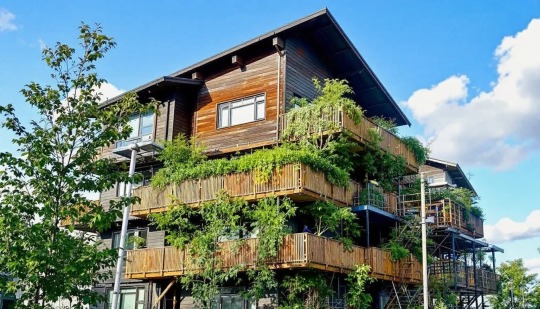
Construction has always evolved with the times, but today's innovations are driven by an urgent need: creating buildings that work with our planet, not against it. As the construction industry in Australia faces growing environmental challenges, new approaches are emerging that promise both sustainability and practicality.
Why Sustainable Building Matters Now
Climate change isn't something that's coming—it's here. The building sector accounts for nearly 40% of global carbon emissions, making it a critical area for improvement. But beyond environmental concerns, sustainable construction offers tangible benefits for builders, owners, and occupants alike:
Lower operating costs through reduced energy consumption
Healthier indoor environments for occupants
Greater resilience against extreme weather events
Enhanced property values and marketability
Meeting increasingly strict building codes and regulations
Game-Changing Materials Transforming Construction
Rethinking Concrete
Concrete has been our go-to building material for centuries, but its environmental impact is substantial. New alternatives are gaining traction:
Green Concrete incorporates recycled materials like fly ash, slag, and crushed glass to reduce its carbon footprint without sacrificing strength. Some formulations capture and store CO2 during curing, turning a carbon source into a carbon sink.
Hemp-Based Building Materials combine hemp fiber with lime to create lightweight, insulating materials that actually sequester carbon. These "hempcrete" products offer excellent thermal performance while being naturally resistant to mold and pests.
Recycled and Upcycled Options
From reclaimed timber to repurposed shipping containers, builders are finding creative ways to give materials a second life. Not only does this reduce waste, but it often results in buildings with unique character and lower embodied carbon.
Smart Design Approaches
Passive House Principles
The Passive House standard focuses on creating ultra-efficient buildings that maintain comfortable temperatures with minimal heating or cooling. Key features include:
Super-insulated building envelopes
Airtight construction with controlled ventilation
Strategic window placement for solar gain management
Thermal bridge-free design
Originally developed for residential buildings, these principles are now being applied to commercial and industrial structures with impressive results.
Biophilic Design
Humans have an innate connection to nature, and biophilic design leverages this relationship to create buildings that support wellbeing. Natural lighting, indoor plants, natural materials, and views of outdoor greenery don't just make spaces more pleasant—they've been shown to reduce stress, improve productivity, and even speed healing in healthcare settings.
Technology's Growing Role
Building Information Modeling (BIM)
BIM technology allows designers to create detailed digital twins of buildings before construction begins. This enables:
Optimization of material usage to reduce waste
Analysis of energy performance under different conditions
Better coordination between trades to prevent costly mistakes
Lifecycle assessment of different design options
Energy Management Systems
Modern buildings are increasingly equipped with sophisticated systems that monitor and optimize energy use in real time. These systems can adjust lighting, heating, cooling, and ventilation based on occupancy patterns and environmental conditions, dramatically reducing energy consumption without sacrificing comfort.
Certifications Raising the Bar
Various certification programs provide frameworks for sustainable building. While LEED has been the most widely recognized, newer systems like Living Building Challenge and WELL are pushing boundaries by focusing on regenerative design and human health impacts.
What's Coming Next?
The future of sustainable building lies in approaches that go beyond merely reducing harm to actively benefiting ecosystems. Concepts gaining momentum include:
Living Buildings that generate more energy than they use, capture and treat their own water, and are constructed from non-toxic, locally sourced materials.
Mass Timber Construction using engineered wood products like cross-laminated timber (CLT) to replace steel and concrete in mid-rise and even high-rise buildings, substantially reducing embodied carbon.
3D Printed Structures that minimize waste through precise material application and can utilize local soil and recycled materials as printing media.
Making Sustainable Building Mainstream
Despite clear benefits, barriers to widespread adoption remain, including higher upfront costs, knowledge gaps, and outdated regulations. However, these obstacles are gradually falling as:
More builders gain experience with sustainable techniques
Supply chains for green materials expand
Building codes evolve to encourage innovation
Clients increasingly demand sustainable options
For industry professionals looking to stay ahead of the curve, investing in sustainability knowledge and partnerships with experienced consultants can provide a competitive edge in a rapidly changing market.
As we face the challenges of climate change and resource constraints, sustainable building isn't just an option—it's becoming the only sensible way forward for the construction industry. By embracing these emerging practices, we can create buildings that are not only kinder to our planet but better for the people who use them every day.
Reference: https://conplant.com.au/news/emerging-sustainable-building-practices/
2 notes
·
View notes
Text
The Dos and Don’ts of AI & ML in Digital Marketing
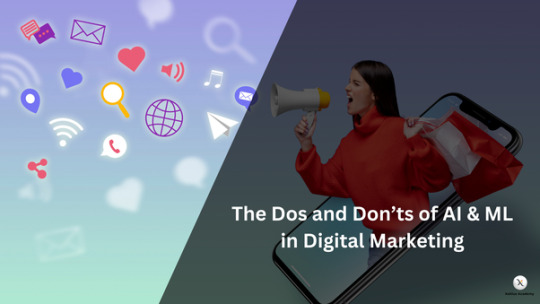
Artificial intelligence (AI) and machine learning (ML) are revolutionizing the digital marketing landscape, offering unprecedented opportunities for personalization, automation, and optimization. However, like any powerful tool, AI and ML must be wielded wisely. This blog outlines the dos and don'ts of leveraging these technologies effectively in your digital marketing strategies.
The Dos:
Do Define Clear Objectives: Before implementing any AI/ML solution, clearly define your marketing goals. What are you trying to achieve? Increased conversions? Improved customer engagement? Specific objectives will guide your AI/ML strategy and ensure you're measuring the right metrics.
Do Focus on Data Quality: AI/ML algorithms are only as good as the data they are trained on. Prioritize collecting clean, accurate, and relevant data. Invest in data cleansing and validation processes to ensure the reliability of your AI-driven insights.
Do Start Small and Iterate: Don't try to implement everything at once. Begin with a specific use case, such as automating social media posting or personalizing email campaigns. Test, refine, and iterate on your approach before scaling up.
Do Prioritize Personalization: AI/ML excels at personalization. Leverage these technologies to create tailored content, product recommendations, and offers for individual customers based on their behavior, preferences, and demographics.
Do Embrace Automation: AI can automate repetitive tasks, freeing up marketers to focus on strategic initiatives. Identify areas where AI can streamline workflows, such as ad campaign optimization, content curation, or customer service interactions.
Do Focus on Transparency and Explainability: Understand how your AI/ML models work and ensure they are transparent and explainable. This is crucial for building trust and addressing ethical concerns.
Do Measure and Analyze Results: Track the performance of your AI/ML-driven marketing campaigns and analyze the data to identify areas for improvement. Use data to inform your decisions and optimize your strategies.
Do Stay Updated: The field of AI/ML is constantly evolving. Keep up with the latest advancements, new tools, and best practices to ensure you're maximizing the potential of these technologies.
The Don'ts:
Don't Treat AI as a Magic Bullet: AI/ML is a powerful tool, but it's not a magic solution. It requires careful planning, implementation, and ongoing management. Don't expect overnight results without putting in the effort.
Don't Neglect Human Oversight: While AI can automate tasks, it's essential to maintain human oversight. Human judgment is still crucial for strategic decision-making, creative development, and ethical considerations.
Don't Over-Rely on Automation: While automation is beneficial, don't over-automate to the point where you lose the human touch. Maintain a balance between automation and human interaction to ensure a personalized and engaging customer experience.
Don't Ignore Ethical Implications: AI/ML raises ethical concerns about data privacy, bias, and transparency. Be mindful of these issues and ensure that your AI-driven marketing practices are ethical and responsible.
Don't Forget About Data Security: Protecting customer data is paramount. Implement robust security measures to safeguard your data from unauthorized access and breaches.
Don't Be Afraid to Experiment: AI/ML is a field of experimentation. Don't be afraid to try new approaches, test different algorithms, and learn from your mistakes.
Don't Underestimate the Importance of Training: Proper training is essential for effectively using AI/ML tools and understanding their capabilities and limitations. Invest in training for your marketing team to ensure they have the skills they need to succeed.
Digital Marketing & AI Certification Program: Your Path to AI-Powered Marketing Mastery
Want to become a sought-after digital marketing professional with expertise in AI and ML? Consider enrolling in a Digital Marketing & AI Certification Program. These programs provide comprehensive training on the latest AI/ML tools and techniques, preparing you to leverage the power of these technologies in your marketing strategies. You'll learn how to:
Develop and implement AI/ML-driven marketing campaigns.
Analyze data and generate actionable insights.
Choose and use the right AI/ML marketing tools.
Address ethical considerations related to AI/ML in marketing.
Conclusion:
AI and ML are transforming the landscape of digital marketing, offering unprecedented opportunities for growth and innovation. By following these dos and don'ts, marketers can harness the power of these technologies effectively and responsibly, driving better results and achieving their marketing goals. The future of digital marketing is intelligent, and it's powered by AI and ML.
#technology#artificial intelligence#online course#ai#marketing#digital marketing#ai in digital marketing
4 notes
·
View notes
Text

Starting an e-commerce business can be an exciting venture with immense potential. However, with the opportunities come challenges and uncertainties. Before diving into the world of online retail, it’s crucial to plan carefully and set a solid foundation. Here are some essential tips to consider before launching your e-commerce business:
1. Conduct Market Research
Understanding the market is fundamental to any successful business. Start by identifying your target audience and analyzing competitors. Research trends, customer preferences, and potential gaps in the market. Tools like Google Trends, social media analytics, and industry reports can provide valuable insights. This research will help you tailor your products or services to meet market demands and differentiate yourself from competitors.
2. Define Your Business Model
E-commerce offers various business models, such as B2C (Business to Consumer), B2B (Business to Business), C2C (Consumer to Consumer), and subscription-based models. Determine which model aligns with your goals and resources. Each model has its own set of challenges and requirements, so choose one that best fits your product or service and target market.
3. Create a Solid Business Plan
A comprehensive business plan serves as a roadmap for your e-commerce venture. Outline your business goals, strategies, target audience, marketing plan, financial projections, and operational plan. This document will not only guide your efforts but also help secure funding if needed. A clear plan can keep you focused and organized as you navigate the complexities of launching and running an e-commerce business.
4. Choose the Right E-Commerce Platform
Selecting the right e-commerce platform is crucial for the success of your online store. Popular platforms like Shopify, WooCommerce, Magento, and BigCommerce each offer unique features and capabilities. Consider factors such as ease of use, scalability, customization options, payment gateways, and integration with other tools. The platform should align with your business needs and provide a user-friendly experience for both you and your customers.
5. Develop a User-Friendly Website
Your website is the face of your e-commerce business. Ensure it’s designed to be user-friendly, visually appealing, and optimized for mobile devices. A clean, intuitive layout with easy navigation will enhance the shopping experience and reduce cart abandonment rates. Focus on high-quality images, detailed product descriptions, and a seamless checkout process. Additionally, implement search engine optimization (SEO) strategies to improve your site’s visibility in search engines.
6. Implement Secure Payment Processing
Security is a top priority in e-commerce. Customers need to trust that their payment information is safe. Choose a reputable payment gateway and ensure your website uses SSL certificates to encrypt data. Additionally, offer multiple payment options, including credit/debit cards, digital wallets, and other payment methods that are popular with your target audience.
7. Plan Your Logistics and Supply Chain
Efficient logistics and supply chain management are vital for e-commerce success. Develop a strategy for inventory management, warehousing, and shipping. Decide whether you’ll handle fulfillment in-house or partner with third-party logistics providers. Consider shipping options, delivery times, and costs. A smooth and reliable fulfillment process can significantly impact customer satisfaction and repeat business.
8. Craft a Marketing Strategy
Effective marketing is essential to drive traffic and sales to your e-commerce store. Develop a multi-channel marketing strategy that includes social media, email marketing, content marketing, and paid advertising. Create engaging content, run promotions, and leverage social media platforms to build brand awareness and attract customers. Monitor and analyze the performance of your marketing efforts to refine your strategies over time.
9. Focus on Customer Service
Exceptional customer service can set your e-commerce business apart from competitors. Provide multiple channels for customer support, such as live chat, email, and phone. Ensure timely responses to inquiries and resolve issues promptly. Building strong customer relationships and encouraging feedback can enhance customer loyalty and drive positive reviews.
10. Monitor and Adapt
The e-commerce landscape is constantly evolving. Regularly review your business performance, track key metrics, and gather customer feedback. Stay informed about industry trends and technological advancements. Be prepared to adapt your strategies and operations based on insights and changes in the market.
#ecommerce#marketing#business#digitalmarketing#ecommercebusiness#entrepreneur#onlineshopping#website#seo#webdesign#b#marketingdigital#onlinebusiness#branding#shopify#smallbusiness#socialmediamarketing#webdevelopment#online#amazon#shopping#onlinestore#onlineshop#design#ecommercewebsite#dropshipping
5 notes
·
View notes
Text
Finding the Right Indian Basmati Rice Supplier for Your Business in 2024

In 2024, the global rice market will continue to boom, with Indian basmati rice emerging as one of the most sought-after varieties. Known for its unmatched aroma, long grain, and excellent cooking quality, basmati rice is a staple in cuisines around the world. For businesses looking to enter this lucrative market or strengthen their supply chain, finding the right supplier is a must. This guide helps you navigate the process, ensuring a reliable partnership that aligns with your goals and enhances your product offerings.
Why Indian Basmati Rice Is Different
Indian basmati rice is synonymous with quality and tradition. Grown in the fertile regions of Punjab, Haryana, and Uttar Pradesh, this rice has earned Geographical Indication (GI) status, highlighting its authenticity and origin.
What makes Basmati rice unique is its aging process, where the grains are matured for several months to enhance their flavor and texture. This has led to an increase in global demand despite fluctuations in rice prices. According to the All India Rice Exporters Association, Indian Basmati will account for more than 70% of the global premium rice trade in 2023, thanks to its unmatched reputation.
Key factors to consider when choosing a supplier
When selecting a Basmati rice supplier, several aspects should be considered to ensure a smooth and profitable collaboration:
Certification and quality standards: Look for suppliers with certifications such as ISO, HACCP and BRCGS, which ensure adherence to global food safety and quality standards.
Market reputation: A supplier’s track record in exporting high-quality rice to global markets reflects their reliability and expertise.
Pricing and transparency: Understand the supplier’s pricing model and ensure clarity on factors that impact rice prices, such as logistics, currency exchange, and market demand.
Capacity and timely delivery: Evaluate if the supplier can meet your volume requirements without compromising on delivery timelines.
Top qualities of a reliable Basmati rice exporter
A reliable Basmati rice supplier has these key qualities:
Authenticity assurance: They source rice from GI-tagged regions, which guarantees a genuine Indian Basmati experience.
Sustainability practices: Many buyers today prefer eco-friendly suppliers who follow sustainable farming and packaging methods.
Client-centric approach: Reliable suppliers prioritize building long-term partnerships by offering customization, competitive pricing, and responsive communication.
Global export experience: Suppliers with a strong network and familiarity with international trade regulations make the export process seamless.
Questions to ask potential suppliers
To make an informed decision, ask potential suppliers the following questions:
Where is your rice sourced and processed?
Make sure the supplier has direct links to GI-certified regions and state-of-the-art processing facilities.
Are there quality checks in place?
Discuss their grading system, inspections, and certifications to confirm product consistency.
How do you manage fluctuations in rice prices?
An active supplier can provide information on market trends and hedging strategies to minimize cost variations.
Can you handle custom packaging or branding?
For businesses looking to add unique value to their product lines, suppliers that offer customization are invaluable.
What is your logistics strategy?
Check if the supplier has efficient shipping methods and partnerships with reliable freight companies to avoid delays.
Choosing the Best Option for Your Business
Finding the right Indian rice supplier is a crucial decision that can significantly impact the success of your business in 2024 and beyond. By focusing on authenticity, quality assurance, and supplier transparency, you can build a partnership that aligns with your goals. With global demand for Indian basmati steadily increasing, now is the right time to invest in securing a reliable supplier.
The key to succeeding in the competitive rice market lies in doing your homework, asking the right questions, and prioritizing long-term value over short-term profit.
2 notes
·
View notes
Text
Top Civil and Structural Engineering Consulting Trends in Singapore
Singapore is known worldwide for its cutting-edge urban landscape, where sustainable development, technology integration, and efficient land use are crucial to the nation's growth. With limited land space and a dense population, civil and structural engineers in Singapore face unique challenges that push them to adopt the latest design, technology, and sustainability trends. As Singapore strives to remain a Smart Nation, civil and structural engineering consultants embrace these trends to drive infrastructure resilience, efficiency, and sustainability.
Below are some of the top civil and structural engineering consulting trends currently transforming the industry in Singapore.
Green and Sustainable Building Practices
As Singapore aims to meet its Green Plan 2030 goals, sustainable building practices have become a cornerstone of civil and structural engineering. Engineering consultants are adopting eco-friendly materials, efficient designs, and green technologies to minimize environmental impact and reduce energy consumption.
Green Mark Certification: Civil and structural engineering firms work closely with the Building and Construction Authority (BCA) to meet Green Mark standards and promote sustainable building practices. Like those in Marina Bay and the Central Business District, green buildings are designed with energy-efficient systems, natural ventilation, and innovative cooling solutions.
Carbon-Neutral Infrastructure: Many consulting firms are incorporating carbon-neutral designs, using renewable energy sources and materials with low embodied carbon. Projects are planned with lifecycle carbon analysis to understand and reduce emissions at each stage of a building's life.
Smart and Digital Infrastructure
Singapore's Smart Nation initiative pushes the envelope to integrate technology with infrastructure. Civil and structural engineers now embed smart sensors, IoT (Internet of Things) devices, and data analytics to optimize building operations, monitor structural health, and ensure safety.
Building Information Modeling (BIM): BIM has become a core tool, allowing engineers to create digital models that enhance project planning, improve coordination, and reduce construction errors. Engineers can simulate various scenarios, identify potential issues, and ensure projects remain on budget and schedule.
Digital Twin Technology: Digital twins – virtual replicas of physical structures – are increasingly used to monitor real-time performance and simulate different operational conditions. This helps facility managers conduct predictive maintenance and optimize the efficiency and lifespan of infrastructure.
Prefabrication and Modular Construction (PPVC)
Prefabricated Prefinished Volumetric Construction (PPVC) and other modular construction techniques are gaining traction in Singapore rapidly. PPVC involves creating modular units off-site, which are then transported to the construction site for assembly, reducing construction time and labor needs.
Reduced On-Site Labor and Waste: Prefabrication significantly reduces on-site and construction waste, addressing Singapore's limited labor pool and sustainability goals. This method also minimizes disruptions in dense urban areas by reducing on-site construction activities.
Quality Control and Faster Project Delivery: Engineering consultants can better monitor quality and adhere to high safety standards by manufacturing components in a controlled factory environment. The streamlined process allows projects to be completed faster without compromising on quality.
Resilient and Climate-Adaptive Design
With Singapore's vulnerability to rising sea levels and extreme weather, resilient and climate-adaptive design has become critical. Civil and structural engineering consultants focus on creating infrastructure to withstand future climate challenges.
Flood-Resistant Infrastructure: Engineers are developing elevated foundations, stormwater management systems, and permeable pavements to prevent flooding in low-lying areas. Coastal areas like Marina Barrage have advanced drainage systems to protect against rising sea levels.
Heat-Resistant and Weather-Proof Materials: Using durable, weather-resistant materials that reduce heat absorption is now a priority. Engineers are incorporating innovative materials that adapt to Singapore's tropical climate, such as cool pavements and high-albedo coatings, which reflect rather than absorb heat.
High-Density and Multi-Use Developments
Singapore's land scarcity drives the trend towards high-density, multi-functional developments that maximize space efficiency. Engineering consultants design buildings that combine residential, commercial, and recreational spaces within the same structure, creating "vertical cities."
Efficient Land Use: High-density buildings make the most of limited land resources, meeting demand for housing, office space, and amenities. These developments reduce travel distances and support walkable, connected communities.
Community-Centric Design: Many developments incorporate public green spaces, communal areas, and easy access to amenities, aligning with Singapore's "City in a Garden" vision and fostering social interaction within urban environments.
Enhanced Safety Standards and Regulatory Compliance
Singapore's strict regulatory environment requires engineering consultants to comply with rigorous safety standards to ensure structural stability, safety, and environmental responsibility.
Advanced Safety Modeling: Safety simulations, using technologies like finite element analysis (FEA), allow engineers to test how buildings will react to stress, wind, and seismic forces. By predicting structural vulnerabilities, engineers can enhance safety and compliance.
Sustainable Compliance and Audits: Engineering firms perform regular sustainability audits to ensure projects meet environmental regulations. Consultants work closely with government bodies to ensure all structures adhere to the latest environmental and safety standards, which is critical for maintaining Singapore's reputation as a global leader in urban planning.
Use of Artificial Intelligence and Machine Learning
Artificial intelligence (AI) and machine learning transform how civil and structural engineering consultants analyze data, predict structural performance, and manage projects.
Predictive Analytics for Maintenance: Machine learning algorithms analyze data from sensors embedded in buildings and infrastructure, identifying wear-and-tear trends to predict when maintenance is required. This predictive approach helps avoid costly repairs and reduces downtime.
Optimized Structural Design: AI is helping engineers design structures with optimal material usage, reducing costs and environmental impact. AI tools can process data from similar projects to propose the most efficient and durable designs for new projects.
Underground and Vertical Expansion
As Singapore's population grows, civil and structural engineers look underground and upward to expand the city-state's usable space. This trend is essential in meeting the demand for infrastructure without encroaching on limited green spaces.
Underground Infrastructure: Singapore is expanding its subterranean network from underground expressways to data centers. Civil engineers are exploring how to optimize underground spaces safely and efficiently, reducing surface congestion.
Skyscraper Engineering: With advancements in structural materials and design techniques, engineering consultants are pushing the boundaries of vertical architecture. Skyscrapers are designed to withstand strong winds, optimize natural light, and incorporate energy-efficient features to minimize environmental impact.
Emphasis on Lifecycle Assessment and Circular Economy
Singapore's construction industry embraces lifecycle assessment and circular economy principles to minimize waste and promote resource efficiency throughout a building's lifespan.
Recycling and Reuse of Materials: Engineering firms are repurposing materials from demolished buildings, reducing demand for new raw materials. By prioritizing recyclable materials in building designs, consultants contribute to Singapore's Zero Waste Master Plan.
Lifecycle-Based Design: By considering the entire lifecycle of structures, from design and construction to decommissioning, engineering consultants can maximize long-term value and sustainability.
Conclusion
Singapore's civil and structural engineering landscape is rapidly evolving as consultants adopt innovative solutions to meet the unique challenges of a growing, land-scarce city. From sustainable building practices to integrating AI and digital technologies, these trends are reshaping Singapore's infrastructure, ensuring it remains resilient, sustainable, and adaptable to future demands. As these trends continue to evolve, Singapore's civil and structural engineers are set to remain at the forefront of global urban innovation, building a future-ready city that balances growth with sustainability.
2 notes
·
View notes